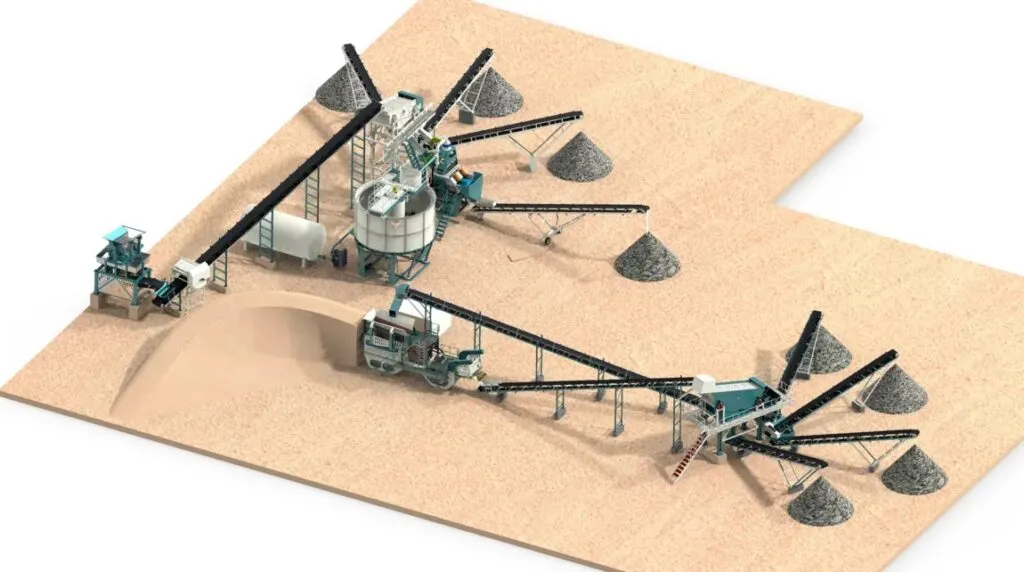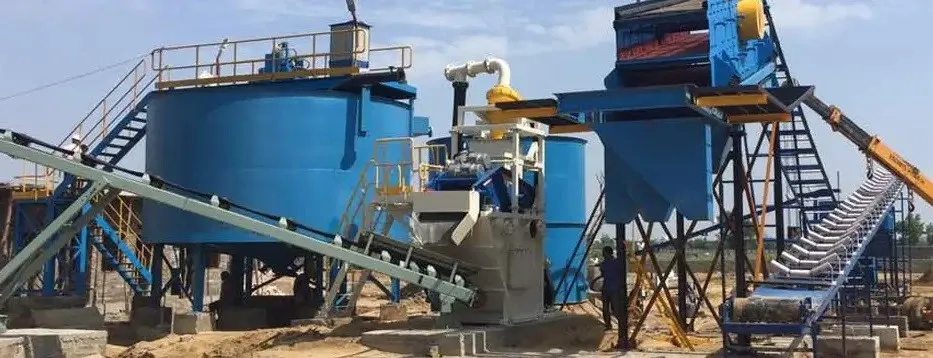Construction and demolition (C&D) waste refers to the waste generated from construction, renovation, and demolition activities. This waste includes a wide variety of materials, such as concrete, bricks, wood, metals, plastics, and other building materials. C&D waste is generated from a range of sources, including residential and commercial buildings, bridges, roads, and other infrastructure projects. C&D waste takes up valuable space in landfills, and the materials can take a long time to decompose, leading to environmental pollution. Moreover, large amounts of waste on land is causing a shortage of dumping places in urban areas. Construction & Demolition, if not managed properly can be a huge urban menace and a major source of air pollution. Therefore, it is necessary to recycle and reuse demolition and concrete wastes. The construction and demolition (C&D) recycling plant is addressing this issue.
It is a specialised recycling plant designed to manage and process waste materials generated from construction and demolition activities.These plants are designed to recover materials that can be reused or recycled, reducing the amount of waste that ends up in landfills such as concrete, wood, metals, asphalt, brick etc. These materials can be sorted and processed using various techniques, such as manual sorting, shredding, screening, and crushing.
Components of construction and demolition (C&D) waste recycling plants
Each plant is customised to the specific requirements of the project. The different levels of contamination, fine content and variability of input materials. Some of its major components include;
- Feed hopper
- Recycler
- Pre-screening
- Washing & Aggregate cleaning
- Trash Screen for removal of light weights
- Sizing Screen for washed Aggregate
- Hydro cyclone system for Sand washing
- Water Management system
- Sludge Management system

Different methods used by construction and demolition (C&D) waste recycling plants
Construction and demolition (C&D) waste recycling plants can use both wet and dry processes to recover different types of materials from the waste stream.
Wet process:
The wet process involves using water to separate and clean the waste materials. The C&D waste is first loaded onto a feeder which evenly spreads it over a rotating drum screen. The drum screen separates the larger materials and sends them to a crusher for further processing. The remaining smaller materials are then fed into a hydro cyclone or water-based gravity separator. The hydrocy clone separates the finer materials such as sand, silt, and clay, while the heavier materials like stones, metals, and plastics are removed using a sink-float separation process. The water used during the process is treated and recycled for reuse.
Dry process:
The dry process involves using air and mechanical methods to separate the waste materials. The C&D waste is first loaded onto a feeder which evenly spreads it over a vibrating screen. The vibrating screen separates the larger materials and sends them to a crusher for further processing. The remaining smaller materials are then passed through an air classifier or electrostatic separator that separates the lighter materials from the heavier ones. The lighter materials such as paper, cardboard, and plastics are separated by an air classifier, while the heavier materials like stones, metals, and concrete are removed using an electrostatic separator. The materials are then transported for further processing or recycling.
The choice of process depends on the type and amount of waste materials to be processed, as well as the environmental regulations and resource availability in the region.
Advantages of construction and demolition (C&D) recycling plants;
- Maximise the recycling of construction, demolition and excavation waste
- Maximise the production of high quality, high value recycled sand and aggregates
- Ensure the ability to meet growing demand for sand and aggregates from a sustainable source
- Protecting sand and aggregate supply in areas where natural reserves are in decline
- Reduce the carbon footprint
- Conserve landfill space
- Conserves finite natural resources.
- Diverts demolition debris bound for disposal

Types of construction and demolition (C&D) waste recycling plants
Construction and demolition (C&D) waste recycling plants can be designed as mobile, semi-mobile, or stationary based on processing capacity, location, and mobility requirements. Here’s an overview of these different types:
1. Mobile C&D waste recycling plants: Mobile recycling plants are designed to be easily transportable and can be moved from one location to another as needed. These plants are typically mounted on trailers or skids and can be towed by a truck to a different site. Mobile recycling plants are ideal for processing small to medium volumes of C&D waste at different locations or temporary construction sites.
2. Semi-mobile C&D waste recycling plants: Semi-mobile recycling plants are designed to be partially portable and can be relocated within a site or to a different site using a trailer or skid. These plants are typically larger than mobile plants and can process higher volumes of C&D waste. Semi-mobile recycling plants are suitable for processing medium to large volumes of waste generated at a specific construction site or demolition project.
3. Stationary C&D waste recycling plants: Stationary recycling plants are designed to be permanently installed at a single location and cannot be moved easily. These plants are typically the largest and most advanced type of recycling plants and can process the highest volumes of C&D waste. Stationary recycling plants are suitable for processing large volumes of waste generated in a city or region over an extended period.
The choice of mobile, semi-mobile, or stationary recycling plant depends on the processing capacity, waste volumes, location, and mobility requirements.
Different types of materials obtained from construction and demolition (C&D) waste recycling plants
Construction and demolition (C&D) recycling plants process a variety of waste materials from construction and demolition projects and recover different types of materials that can be used for various purposes. Here are some common materials that can be obtained from C&D recycling plants:
1. Aggregates: C&D recycling plants can recover aggregates such as concrete, brick, and asphalt to produce recycled aggregates.
2. Metals: C&D recycling plants can recover ferrous and non-ferrous metals such as steel, copper, and aluminum from construction and demolition waste.
3. Wood: C&D recycling plants can recover wood waste such as lumber, pallets, and plywood, which can be chipped or ground into wood chips and used for mulch, biomass energy, or other purposes.
4. Plastics: C&D recycling plants can recover plastics such as PVC, HDPE, and PET from construction and demolition waste.
5. Gypsum: C&D recycling plants can recover gypsum waste from drywall and plaster to produce recycled gypsum powder.

Demand for construction and demolition (C&D) recycling plants
There has been significant growth in demand for construction and demolition (C&D) recycling plants in India.
Kolkata on 28th April 2023, got its first Construction and demolition (C&D) waste recycling plant with a capacity of 1600 tonnes per day in New Town spread across 5 acres. The facility will be operated by environment management services firm Re Sustainability (ReSL) and Kolkata Municipal Corporation in a public-private partnership.
Other developments
- Construction waste recycling plant to come up in Trichy capacity to recycle 50 tonnes per day
- Bhubaneswar civic body to establish construction waste processing unit capable of recycling 100 tonnes of waste per day
- Madurai is building a waste processing plant and will have the capacity to process 100 tonnes per day
- Patna civic body is also setting up 4 plant for waste management
Conclusion
The Indian market is embracing the need of recycling construction and demolition wastes. The rise in awareness among public and government agencies about recycling and reusing waste material and the development of advanced waste recycling solutions are expected to provide lucrative growth opportunities for construction and demolition (C&D) recycling plant manufacturers.
Image Source: cdegroup.com, picsinternational.com, turmec.com, duromech.in

